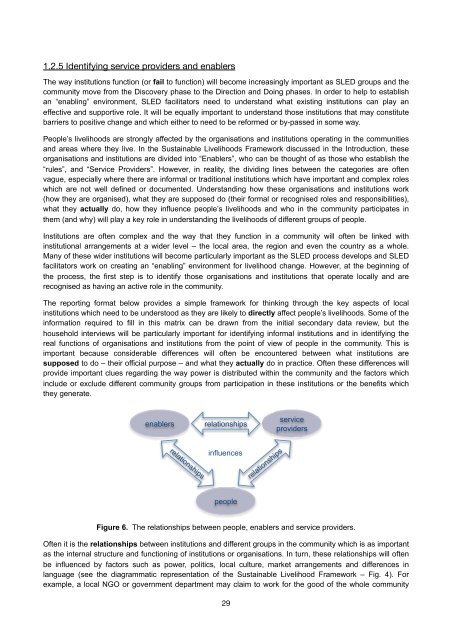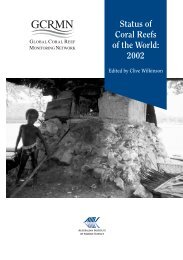Sustainable Livelihoods Enhancement and Diversification (SLED)
Sustainable Livelihoods Enhancement and Diversification (SLED)
Sustainable Livelihoods Enhancement and Diversification (SLED)
Create successful ePaper yourself
Turn your PDF publications into a flip-book with our unique Google optimized e-Paper software.
1.2.5 Identifying service providers <strong>and</strong> enablers<br />
The way institutions function (or fail to function) will become increasingly important as <strong>SLED</strong> groups <strong>and</strong> the<br />
community move from the Discovery phase to the Direction <strong>and</strong> Doing phases. In order to help to establish<br />
an “enabling” environment, <strong>SLED</strong> facilitators need to underst<strong>and</strong> what existing institutions can play an<br />
effective <strong>and</strong> supportive role. It will be equally important to underst<strong>and</strong> those institutions that may constitute<br />
barriers to positive change <strong>and</strong> which either to need to be reformed or by-passed in some way.<br />
People’s livelihoods are strongly affected by the organisations <strong>and</strong> institutions operating in the communities<br />
<strong>and</strong> areas where they live. In the <strong>Sustainable</strong> <strong>Livelihoods</strong> Framework discussed in the Introduction, these<br />
organisations <strong>and</strong> institutions are divided into “Enablers”, who can be thought of as those who establish the<br />
“rules”, <strong>and</strong> “Service Providers”. However, in reality, the dividing lines between the categories are often<br />
vague, especially where there are informal or traditional institutions which have important <strong>and</strong> complex roles<br />
which are not well defined or documented. Underst<strong>and</strong>ing how these organisations <strong>and</strong> institutions work<br />
(how they are organised), what they are supposed do (their formal or recognised roles <strong>and</strong> responsibilities),<br />
what they actually do, how they influence people’s livelihoods <strong>and</strong> who in the community participates in<br />
them (<strong>and</strong> why) will play a key role in underst<strong>and</strong>ing the livelihoods of different groups of people.<br />
Institutions are often complex <strong>and</strong> the way that they function in a community will often be linked with<br />
institutional arrangements at a wider level – the local area, the region <strong>and</strong> even the country as a whole.<br />
Many of these wider institutions will become particularly important as the <strong>SLED</strong> process develops <strong>and</strong> <strong>SLED</strong><br />
facilitators work on creating an “enabling” environment for livelihood change. However, at the beginning of<br />
the process, the first step is to identify those organisations <strong>and</strong> institutions that operate locally <strong>and</strong> are<br />
recognised as having an active role in the community.<br />
The reporting format below provides a simple framework for thinking through the key aspects of local<br />
institutions which need to be understood as they are likely to directly affect people’s livelihoods. Some of the<br />
information required to fill in this matrix can be drawn from the initial secondary data review, but the<br />
household interviews will be particularly important for identifying informal institutions <strong>and</strong> in identifying the<br />
real functions of organisations <strong>and</strong> institutions from the point of view of people in the community. This is<br />
important because considerable differences will often be encountered between what institutions are<br />
supposed to do – their official purpose – <strong>and</strong> what they actually do in practice. Often these differences will<br />
provide important clues regarding the way power is distributed within the community <strong>and</strong> the factors which<br />
include or exclude different community groups from participation in these institutions or the benefits which<br />
they generate.<br />
enablers<br />
relationships<br />
service<br />
providers<br />
relationships<br />
influences<br />
relationships<br />
people<br />
Figure 6. The relationships between people, enablers <strong>and</strong> service providers.<br />
Often it is the relationships between institutions <strong>and</strong> different groups in the community which is as important<br />
as the internal structure <strong>and</strong> functioning of institutions or organisations. In turn, these relationships will often<br />
be influenced by factors such as power, politics, local culture, market arrangements <strong>and</strong> differences in<br />
language (see the diagrammatic representation of the <strong>Sustainable</strong> Livelihood Framework – Fig. 4). For<br />
example, a local NGO or government department may claim to work for the good of the whole community<br />
29
















